
|   |

|   |
Varsha Utsav - Dr. Sunil Kothari e-mail: sunilkothari1933@gmail.com Photos courtesy: Adhyasha September 13, 2013 Visiting Bangalore soon after centenary celebrations of Mohanrao Kallianpurkar to attend Varsha Utsav organized by Adhyasha Odissi Dance Ensemble run by Odissi exponent Sarita Mishra, it was indeed a pleasure to meet another devotee of Odissi based in Bangalore, performing, teaching and organizing programs enlisting support from Bangalore based local senior and contemporary dancers. I had not met her or known her earlier, but seeing her work, dedication, enthusiasm and high standard of her own dance, I was duly impressed. Sarita Mishra hails from Bhubaneswar. Her husband Uttam Rath is a military officer. Though he has to move from city to city, his stay in Bangalore offered Sarita scope to start an institution to teach Odissi to young dancers and also elder women interested in dance. Within two years she succeeded in gathering around her few talented dancers, including those who have had training in Bharatanatyam and worked assiduously to build up an enjoyable repertoire. Trained earlier by Niranjan Rout and Padma Charan Dehuri, she is currently receiving training under Guru Bichitrananda Swain. Possessing a pleasant personality, she seems to be steeped into Odissi and from what I saw and later on interacting with her, I found that she has a solid strong background of culture of Odisha, dance traditions, festivals and rituals. The storehouse of traditional songs she has, I shared with relish and was very happy to see some of them being performed in group composition. She succeeded in inviting the luminaries from Bhubaneswar, the leading lights of present day Odissi, both musicians and exponents. Odissi exponent Guru Bichitrananda Swain, mardala exponent Guru Dhaneswar Swain, Odissi vocalist, musician, composer Guru Ram Hari Das, Odissi exponent Sujata Mohapatra and also Chittaranjan Mallia, secretary of Odissi Sangeet Natak Akademi, an authority on Gotipua dance tradition and a scholar, participated in the two day festival, displaying their art and gave an enchanting glimpse into Odissi dance and music. Sarita's own repertoire, her choreography of few numbers, and her solo showcased the sound training she has received and also her attempts to choreograph a variety of numbers. On the opening day of August 16, Guru Dhaneshwar Swain presented solo mardala playing, and revealed a variety of talas prevalent in traditional Odissi and command over mardala. He has received training from great gurus including Banamali Maharana. He has to his credit various tala compositions he provides dancers in their compositions. His playing is full of clarity and even when one sees the complexities in Odissi tala patterns his playing makes it easy to follow. He has been working on presenting solo mardala playing on stage, giving the instrument its due honour and position among percussion instruments. Extremely humble and self effacing Dhaneswar Swain is an asset to the Odissi dance. He set the tone for the evening. 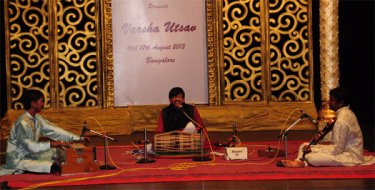 Guru Dhaneshwar Swain  Adyasha ensemble Sarita's troupe opened the Odissi suite with Mangalacharan describing the beauty of Lord Krishna with shloka “Bhaje vrajeka mandana” and how the Lord saves his devotees. The dancers were Radhika Makaram, Vandana Supriya, Sweta Krishna and Yashomati Mishra. They did justice to the choreography by Guru Bichitrananda Swain. The music was by Bijay Kumar Jena and mardala by Bijay Kumar Barik. It was followed by Basant Pallavi, a nritta piece. Pallavis are an integral part of Odissi exposition. With its hauntingly melodious rendering and sculptural poses woven in pure dance, Pallavi is always a pleasure in music and dance. It was performed by Sai Srishti Rath, Ishanee Mitra, Manasi Nayak, Mugdha Samanta, Shifa Zoya, Sahana Kakaria, Namrata Katrala, Suhana Medappa. It was heartening to see so many of Sarita's students participating and showing what they have been learning under her guidance. The delight was to listen to traditional Odiya songs, in particular by Banamali Das. Radha tells the sakhi that the moment I saw Brajakumar “O go, nasile bibek mor,” I lost all my consciousness and was under a spell. The forest, the animals, the water of river Yamuna are all mesmerized on listening to his flute. Choreographed imaginatively and performed as a group number by Namrata Katrela, Shifa Zoya, Sahana Kakarla, Ishanee, Mugdha Samanta and others it was a captivating number with an old world charm. It also in a way revived the quintessential charm of Odissi poems and its hold over the public. The next number describing the Lord being taken in palanquin to Chandan pokhri in a procession, the application of cool sandal paste and the devadasis singing his praise, his beauty, the stanza “Mani Bimane Govinda” of Banamali Das set to traditional tunes, took one to the 'bado danda,' the big street where the procession with a variety of musical instruments collected crowds to see Lord Madanagopal on way to Narendra pond. “Mani Bimane Govinda, chaupase gheri chhanti sahachari brinda” (surrounded by the beauteous women) and then the refrain of the song “Jhulavo go Kishore Kishori kana, Kishore Kishori kunje khelu chhanti ana” (see the divine couple on the swing) with Sarita's daughter Sai Shrishti as Radha and Ishanee Mitra as Krishna stole the show. As Kishore and Kishori they looked charming and evidently they performed with relish. Sai Srishti has potential to flower into a fine dancer as has Ishanee Mitra. Sarita's solo 'Ganga' was a tour de force as Sarita narrated and enacted the story of how Ganga descended on the locks of Lord Shiva, losing her pride and turning into a mere trickle. Bhagirath prayed again to Lord Brahma to show the way and let Ganga flow and bring the 100 sons alive with her water. The treatment of the theme then turns into Ganga's plight with pollution, bodies, burning bodies after death on the ghat, everything mixing in the water and making it unclean. The suggestive contemporary interpretation was imaginative and one complimented Guru Bichitrananda Swain and Sarita for this brilliant touch. To show that folk tradition is also a part of training at her institute, Sarita had a Sambalpuri folk dance for young dancers. 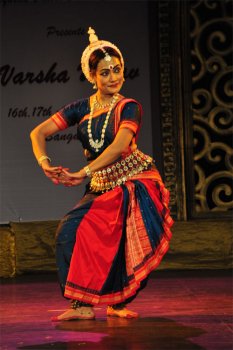 Sarita Mishra 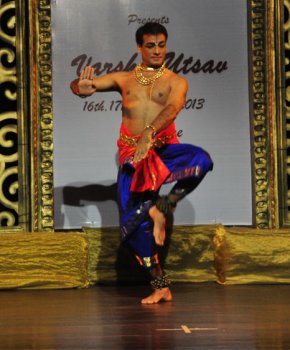 Sathyanarayana Raju In Bharatanatyam, Bangalore's superstar Sathyanarayana Raju performed Tanjore Quartette's varnam addressed to Lord Brihadeeshwara. Though the varnam's central figure is a nayika, Sathyanarayana with great dexterity and subtle nuances of a nayika, complained to the Lord for ignoring her and requested him to accept her. His abhinaya was convincing as a nayika and the pure dance was flawless. The 30 minute long abbreviated varnam was a feather in Sathyanarayana's cap. Disciple of late Narmada, he has a sound grounding in Bharatanatyam. His performance shone forth like a diamond. The finale was by the young female Kathak dancers of Noopur Performing Arts Centre run by Hari and Chethana. Dressed in dazzling colourful costumes, they performed Sarasvati Vandana, sargam in raga Malhar taking exquisite chakkars, executing movements and footwork in sync with percussion. The live music would have added to the necessary 'punch' in terms of arriving on 'sam.' However, it must be said to the credit of all dancers led by Chethana that they performed well and won the customary rounds of applause. One missed Hari as he was touring abroad. The first day's performance ended with a joyous mood. 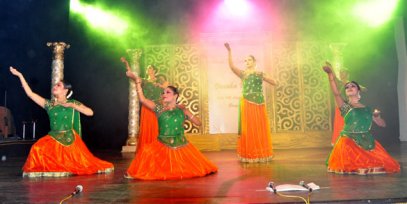 Noopur ensemble 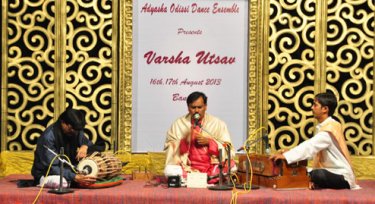 Guru Ram Hari Das On the second day, Guru Ram Hari Das opened the festival with his mellifluous singing introducing Odissi music in its multiple varieties. I am a fan of Ram Hari Das. Our association goes a long way. When I was doing research in Odissi for my book on Odissi published by Marg Publications, I used to visit Cuttack and Bhubaneswar to learn about various aspects of Odissi. Priyamvada Mohanty would invite Ram Hari Das who used to sing many Odiya songs to explain to me forms like Janano, Chhanda, Champu, traditional songs, the specialty of rendering ashtapadis of the Gita Govinda, the 'bhava ang' of Odissi music, the 'natya ang' and so on. Today he is a leading musician in Odisha with several honours, including Sangeet Natak Akademi award bestowed upon him for his contribution to Odissi music. He served as Chief Executive of Guru Kelucharan Mohapatra Odisssi Research Centre, as Professor of Music at University of Culture, Bhubaneswar, and has over the years composed innumerable songs for Odissi dancers for their choreographic works and is busy expanding the horizons of Odissi music. He explained the special 'andolika' elements of Odissi music. As 'Jhulan jatra' was on, he rendered a song specific to that mood. He gave examples of Champu, song describing Rama and Sita during Swayamvara. The swara taan and aakar were interwoven in his rendering. The Gita Govinda ashtapadi 'Sakhi he Keshimathanamudaram' won over the hearts of Karantaka musicians in the audience. Rendered in Shudh Desh, it had exquisite emotive quality and dignity which had an instant appeal. There was a welcome combination of traditional music prevalent in Odisha and classical elements which distinguishes Odissi music as a special genre. Guru Bichitrananda Swain presented Mangalacharan followed by story of Shurpanakha. A gifted dancer and a guru, he created before our eyes Panchavati where Lord Rama and Sita were seen in amorous mood. Seeing them, Shurpanakha feels jealous of Sita, transforms herself into a beautiful woman to entice Rama, who sends her to Lakshmana who chops off her nose and ears. She screams and announces to take revenge and runs away. The transformation into beautiful Shurpanakha was achieved by Bichitrananda in a delicate manner. He is a very gifted guru and is known for his imaginative choreography. However, his health was not in his favour and he appeared fatigued. He would do well to take care of his health as dance is a physical art and the strain shows. 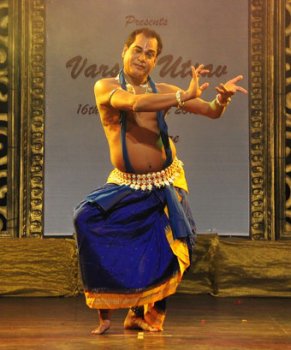 Guru Bichitrananda Swain 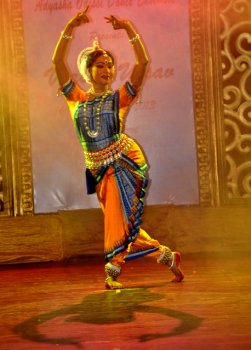 Sujata Mohapatra Sujata Mohapatra has won fame for her flawless and exquisite performances for the past twenty years. She is at the peak of her career. With thorough grounding in her father-in-law Kelucharan Mohapatra's technique under his guidance, she is now known for her strict adherence to Kelubabu's style. With a svelte figure, with command over tala and laya, holding sculpturesque poses in arresting manner, Sujata invariably mesmerizes her audiences. Her Hamsadhwani Pallavi displayed her nritta in all its glory. The lighting was imaginative to sculpt her figure. In the song “Braja ku chor ashichi” in which Yashoda cajoles Lord Krishna, Sujata impersonated Bakasura and other creatures to scare Krishna, but the darling son of hers would not go to sleep. Finally she succeeds and the child falls asleep. The vatsalya bhava (motherly love) had instant appeal. But what was most enticing was 'Varsha' from Kalidasa's Ritusamharam choreographed by Ratikant Mohapatra to the music by Raghunath Panigrahi. The season's moods were captured well through the dancing peacock. Her movements of the bird were captivating. Graceful, proud, gentle walk, spreading of his feathers and looking up at the clouds, all had a lyrical quality. Sujata won over audiences with her brilliant dancing. The finale choreographed in Bharatanatyam and Kuchipudi by Veena Murthy was thematic. 'Six passions' Arishadvarga was an excellent concept. What happens when one succumbs to the temptations was etched out well by the dancers. Urvashi, as a result of Kama (desire), Shiva for Krodha (ire), Kaikeyi for Lobha (greed) Sita / Ravana for Moha (lust) - Sita for lust for golden deer and Ravana for his lust for Sita - Ganga for Mada (arrogance) and Duryodhana for Matsara (pride). It was good to see Dipti, daughter of Suma Sudhindra, in Bharatanatyam, taking to stage now regularly. The other young female dancers performed Kuchipudi with usual verve and fast tempo. The male dancer had a difficult time to quickly change costumes. Veena Murthy is a seasoned dancer and guru. Perhaps on account of time constraints the presentation looked hurried. Sarita Mishra's Varsha Utsav for two days gave the audience along with Odissi, glimpses of variety of dance forms. The participation by local artistes was indicative of the goodwill Sarita has won. I am sure in coming years Sarita's institution shall raise the bar of Odissi dance in Bangalore.  Dr. Sunil Kothari is a dance historian, scholar, author and a renowned dance critic. He is Vice President of World Dance Alliance Asia Pacific India chapter, based in New Delhi. He is honored by the President of India with Padma Shri, Sangeet Natak Akademi award and Senior Critic Award from Dance Critics Association, NYC. He is a regular contributor to www.narthaki.com, the roving critic for monthly magazine Sruti and is a contributing editor of Nartanam for the past 12 years. Post your comments Pl provide your name and email id along with your comment. All appropriate comments posted with name and email id in the blog will also be featured in the site. |